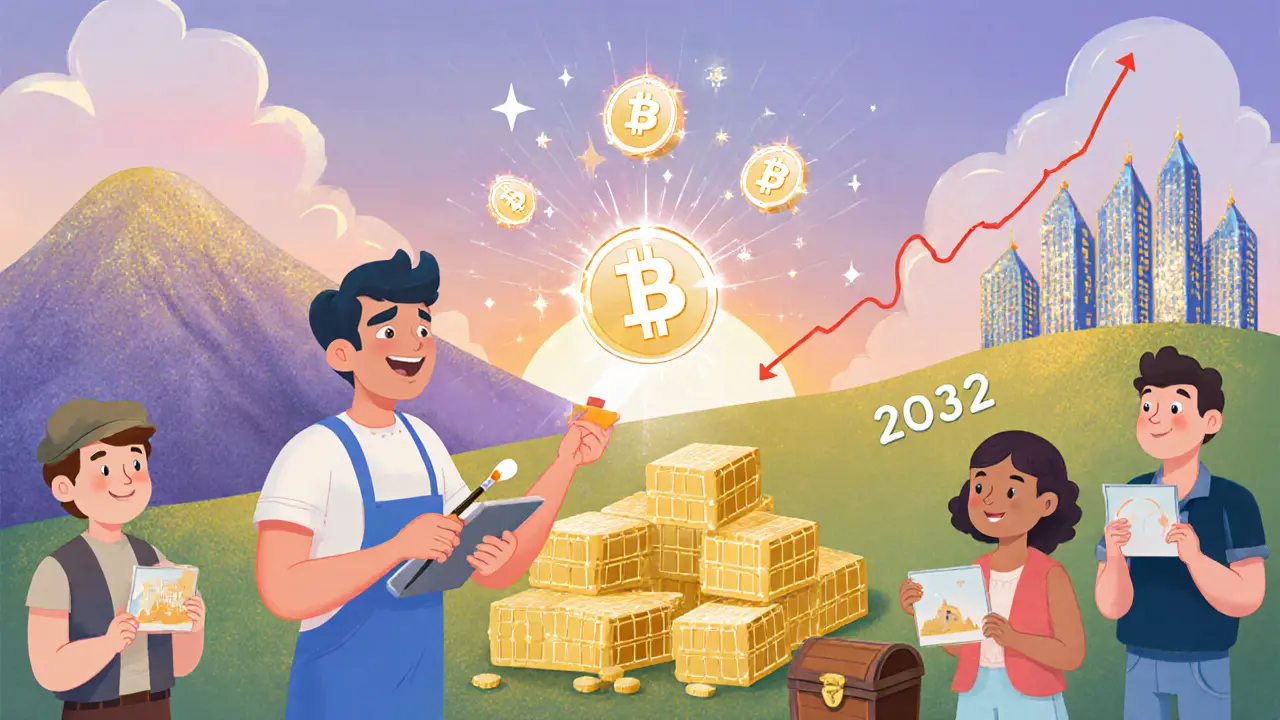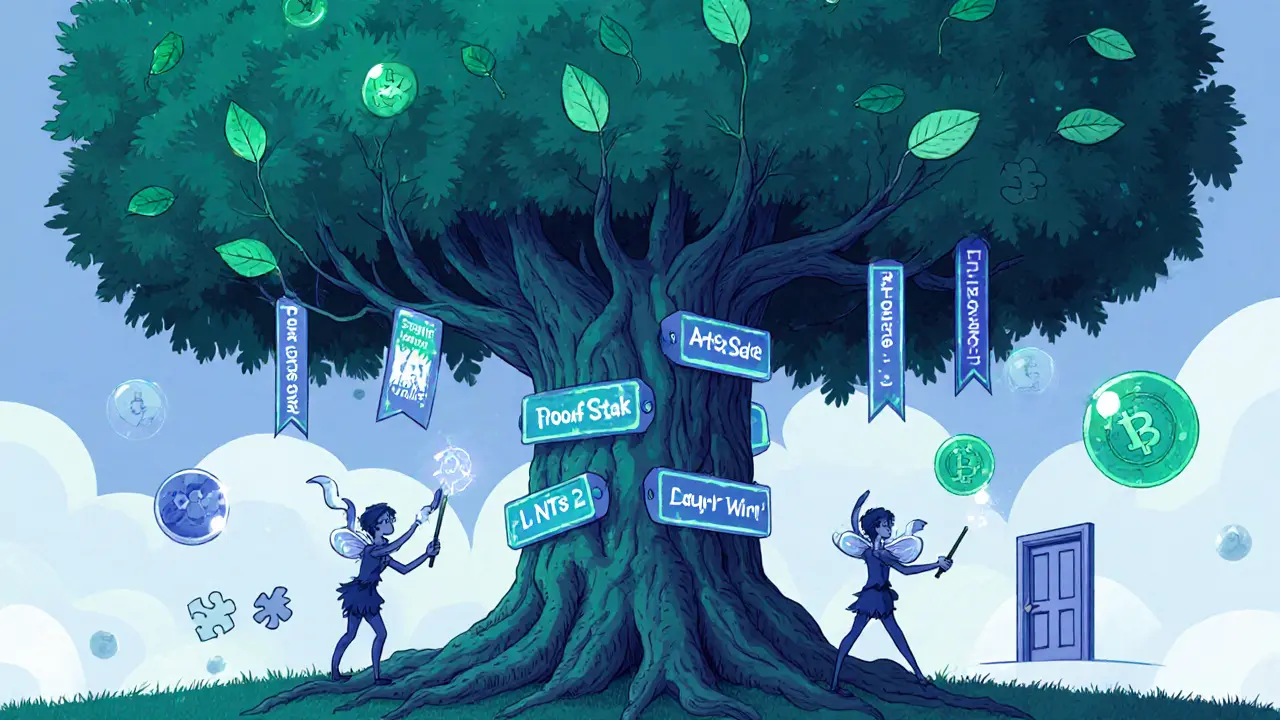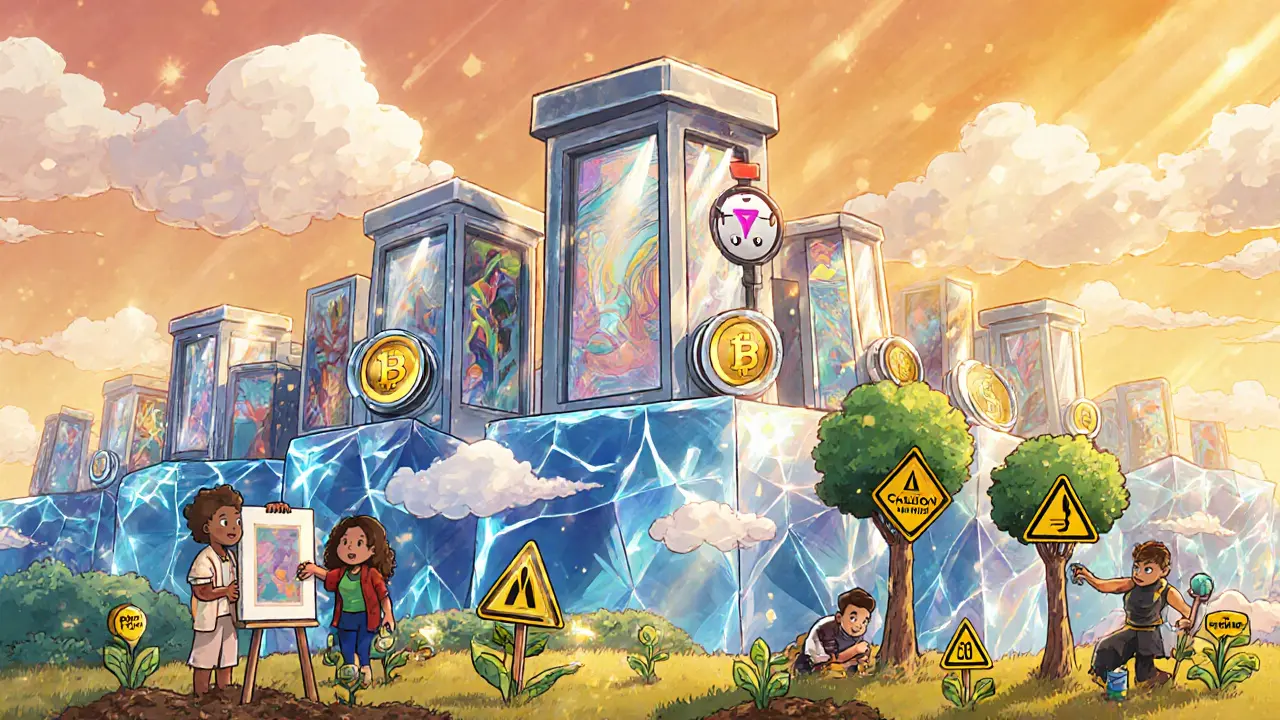Posted By Tristan Valehart On 16 Oct 2025 Comments (1)

NFT Royalty Calculator
Royalty Earnings Calculator
Results
Total Royalties Earned
Per Resale
Summary
Key Insight
Quick Takeaways
- The global digital‑art market on blockchain is set to grow at a 17.3% CAGR, reaching $17.7billion by 2032.
- AI‑generated NFTs, utility tokens, and cross‑chain solutions are the main growth drivers.
- Smart‑contract royalties, fractional ownership and DeFi integration turn art into a financial asset.
- Environmental impact, gas fees and technical complexity remain the biggest hurdles.
- Artists can launch a blockchain‑ready piece in 2-4weeks with the right tools and wallet.
When you hear "digital art on blockchain", you’re hearing about a market that has gone from a speculative meme‑fuel in 2021 to a mature ecosystem that blends creativity, finance, and technology. In 2025 the sector sits at $5.8billion, and analysts forecast it will triple by 2032. That growth isn’t just numbers - it’s a shift in how creators earn, collectors verify authenticity, and brands experiment with new revenue streams.
Digital Art is visual or multimedia work created using digital tools, ranging from static images to immersive 3‑D installations.
When digital art lives on a blockchain, it inherits three core benefits: immutable provenance, programmable royalties, and global marketplace access. Below we break down the forces shaping the future, the tech that makes it possible, and the practical steps artists need to take.
1. Market Momentum and Growth Drivers
Search‑interest data shows a ten‑fold jump in Google queries about blockchain art between August2024 (index 6) and August2025 (index 36). Peaks in March and June 2025 line up with two landmark announcements: AI‑enhanced NFT platforms and the first large‑scale sustainability‑focused collections on OpenSea.
Key growth pillars include:
- AI‑generated and dynamic NFTs - artworks that evolve with real‑time data or viewer interaction.
- Utility tokens - NFTs that unlock event tickets, exclusive Discord channels, or in‑game items.
- Cross‑chain interoperability - moving assets between Ethereum, Solana, and emerging Layer‑2 networks.
- Institutional participation - Sotheby’s and traditional auction houses now list NFTs alongside physical pieces.
2. Technical Infrastructure
The backbone is the Blockchain itself, a distributed ledger that stores transaction data in immutable blocks. On top of that, Smart Contracts automate royalty payments, enforce usage rights, and enable fractional ownership.
Important tech trends:
- Proof‑of‑Stake (PoS) consensus - reduces energy consumption by 99% compared with legacy Proof‑of‑Work (PoW) chains.
- Layer‑2 scaling solutions - Optimistic Rollups and ZK‑Rollups cut gas fees to under $0.10 per transaction.
- Multi‑wallet integration - MetaMask, Phantom, and Trust Wallet now support seamless cross‑chain swaps.
- DeFi bridges - protocols like NFTX let creators stake NFTs for yield or borrow against them.

3. Opportunities for Creators
Artists are no longer limited to a one‑time sale. The new toolkit includes:
- Programmable royalties - 5-10% of every resale automatically returns to the creator.
- Fractional ownership - Mint a “share token” for a high‑value piece; each holder gets a slice of future sales.
- Utility NFTs - Offer token‑gated access to virtual galleries, live‑streamed performances, or physical prints.
- Gaming collaborations - Partner with blockchain games to embed artwork as in‑game skins that can be traded.
- AI‑driven generative series - Use tools like Adobe Generative Fill to produce thousands of variations, each minted as a unique token.
4. Challenges and Risks
Despite the promise, several pain points still hold back mass adoption:
- Environmental concerns - Even PoS networks face criticism, though the carbon footprint is now comparable to traditional cloud services.
- Transaction fees - While Layer‑2 solutions lower costs, users on Ethereum still encounter spikes during network congestion.
- Price volatility - Crypto market swings can erode the fiat value of NFT sales.
- Technical onboarding - Setting up a wallet, buying native tokens for gas, and understanding smart contracts can take 2-4weeks for a novice.
- Regulatory uncertainty - Different jurisdictions treat NFTs as securities, collectibles, or intangible assets.
5. Future Outlook (2026‑2032)
Analysts at Gartner predict overall blockchain business value will top $3trillion by 2030, and the creative sector will capture a sizable slice. Key forecasts:
- By 2028, utility NFTs will account for >40% of total NFT transaction volume.
- Fractional ownership platforms will enable $2billion in secondary‑market liquidity for art assets.
- Major museums will adopt blockchain provenance tools to certify both digital and physical collections.
- Education programs in art schools will embed blockchain basics into curricula, lowering the entry barrier.
In short, blockchain‑based digital art is moving from “novelty” to “infrastructure”. Artists who adopt early‑stage tools and focus on utility will likely capture the biggest share of future revenue.

6. Getting Started: A Practical Checklist for Artists
- Choose a blockchain - Ethereum for broad exposure, Solana for low fees, or a Layer‑2 like Arbitrum for a balance.
- Set up a wallet - Install MetaMask (Chrome) or Phantom (Firefox), secure the seed phrase.
- Acquire native tokens - Buy ETH, SOL, or the chosen network’s coin to cover gas.
- Create smart‑contract metadata - Use standards like ERC‑721 or ERC‑1155; include royalty percentages.
- Mint the artwork - Upload the file to IPFS or Arweave for decentralized storage, then mint via a marketplace (OpenSea, Magic Eden).
- Enable utility - Link the NFT to a private Discord, a physical print, or a streaming event.
- Promote - Leverage Twitter/X, Instagram, and niche NFT communities; monitor analytics.
- Iterate - Track resale royalties, gather feedback, and consider launching a series.
Most artists achieve a functional launch within three weeks; mastering advanced features like staking or cross‑chain bridges typically adds another month of learning.
7. Comparison: AdvantagesvsDisadvantages of Blockchain Digital Art
| Aspect | Advantages | Disadvantages |
|---|---|---|
| Ownership | Immutable proof of provenance; instant verification. | Requires understanding of wallets and private keys. |
| Royalties | Smart contracts auto‑pay creators on every resale. | Royalty percentages limited by marketplace policies. |
| Market Reach | Global audience, 24/7 trading. | Still niche; mainstream collectors often unfamiliar. |
| Environmental Impact | PoS and Layer‑2 dramatically cut energy use. | Legacy PoW chains still consume high power. |
| Utility | Token‑gated events, in‑game items, fractional ownership. | Complex to design and communicate utility value. |
8. Frequently Asked Questions
What is the difference between an NFT and a regular digital image?
An NFT is a token on a blockchain that records ownership, scarcity, and provenance. A regular image can be copied endlessly, while an NFT’s ledger entry makes each token unique and traceable.
Do I need to be a programmer to mint an NFT?
No. Most marketplaces offer one‑click minting tools that hide the code. Understanding basic wallet setup and gas fees is enough for a start.
How can I earn royalties after the first sale?
Include a royalty clause in the NFT’s smart contract (e.g., ERC‑2981). Each time the token is resold, the contract sends the preset percentage automatically to your wallet.
Are NFTs environmentally friendly?
Proof‑of‑Stake blockchains like Solana, Polygon, and the Ethereum Layer‑2 rollups consume far less energy than legacy Proof‑of‑Work networks. Choosing those alternatives mitigates most environmental concerns.
What is a utility NFT?
A utility NFT grants real-world or digital benefits beyond ownership-such as exclusive event tickets, access to private Discord servers, or in‑game items that affect gameplay.
Whether you’re a painter, 3‑D modeler, or generative‑AI creator, the blockchain landscape now offers tools that turn a single artwork into a revenue‑generating ecosystem. Keep an eye on sustainability upgrades, emerging Layer‑2s, and the growing demand for token‑gated experiences-those are the chances to stay ahead of the curve.

Teagan Beck
October 16, 2025 AT 09:33Digital art on the blockchain is finally getting some real momentum.